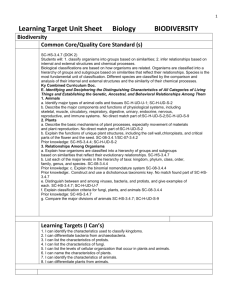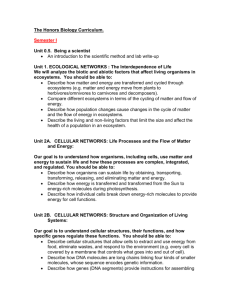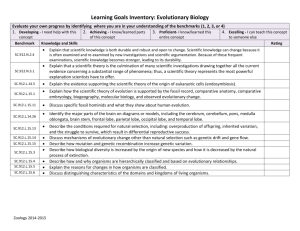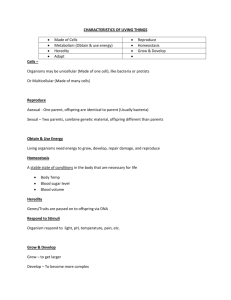I can describe the genetic variability of offspring due to mutations
advertisement
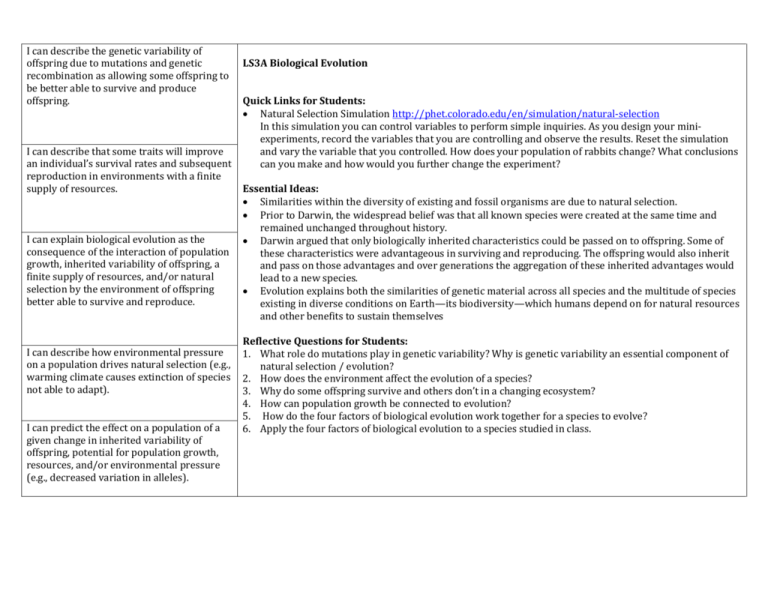
I can describe the genetic variability of offspring due to mutations and genetic recombination as allowing some offspring to be better able to survive and produce offspring. I can describe that some traits will improve an individual’s survival rates and subsequent reproduction in environments with a finite supply of resources. I can explain biological evolution as the consequence of the interaction of population growth, inherited variability of offspring, a finite supply of resources, and/or natural selection by the environment of offspring better able to survive and reproduce. I can describe how environmental pressure on a population drives natural selection (e.g., warming climate causes extinction of species not able to adapt). I can predict the effect on a population of a given change in inherited variability of offspring, potential for population growth, resources, and/or environmental pressure (e.g., decreased variation in alleles). LS3A Biological Evolution Quick Links for Students: Natural Selection Simulation http://phet.colorado.edu/en/simulation/natural-selection In this simulation you can control variables to perform simple inquiries. As you design your miniexperiments, record the variables that you are controlling and observe the results. Reset the simulation and vary the variable that you controlled. How does your population of rabbits change? What conclusions can you make and how would you further change the experiment? Essential Ideas: Similarities within the diversity of existing and fossil organisms are due to natural selection. Prior to Darwin, the widespread belief was that all known species were created at the same time and remained unchanged throughout history. Darwin argued that only biologically inherited characteristics could be passed on to offspring. Some of these characteristics were advantageous in surviving and reproducing. The offspring would also inherit and pass on those advantages and over generations the aggregation of these inherited advantages would lead to a new species. Evolution explains both the similarities of genetic material across all species and the multitude of species existing in diverse conditions on Earth—its biodiversity—which humans depend on for natural resources and other benefits to sustain themselves Reflective Questions for Students: 1. What role do mutations play in genetic variability? Why is genetic variability an essential component of natural selection / evolution? 2. How does the environment affect the evolution of a species? 3. Why do some offspring survive and others don’t in a changing ecosystem? 4. How can population growth be connected to evolution? 5. How do the four factors of biological evolution work together for a species to evolve? 6. Apply the four factors of biological evolution to a species studied in class. I can describe that changes caused by mutations will often be harmful, but a small minority of mutations will cause changes that allow the offspring to survive longer and reproduce more. LS3B Random Change Quick Links for Students: I can predict how a given trait or mutation will allow a species to survive and reproduce in a given environment. Natural Selection Simulation http://phet.colorado.edu/en/simulation/natural-selection In this simulation you can control variables to perform simple inquiries. As you design your miniexperiments, record the variables that you are controlling and observe the results. Reset the simulation and vary the variable that you controlled. How does your population of rabbits change? What conclusions can you make and how would you further change the experiment? Activity on variation http://learn.genetics.utah.edu/content/variation/sources/ Essential Ideas: Information passed from parents to offspring is coded in the DNA molecules that form the chromosomes. In sexual reproduction, chromosomes can sometimes swap sections during the process of meiosis (cell division), thereby creating new genetic combinations and thus more genetic variation. Although DNA replication is tightly regulated and remarkably accurate, errors do occur and result in mutations, which are also a source of genetic variation. Environmental factors can cause mutations in genes, and viable mutations are inherited. Environmental factors also affect expression of traits, and hence affect the probability of occurrences of traits in a population. Thus the variation and distribution of traits observed depends on both genetic and environmental factors. Reflective Questions for Students: 1. How do mutations and environment drive evolution? 2. Why do some offspring survive and others do not in a changing ecosystem? 3. How does genetics and the environment work together for the survival of a species? 4. What is the effect of a changing climate on organisms and their evolution? I can explain that species alive today have diverged from a common ancestor (e.g., by interpreting diagram representing an evolutionary tree). LS3C Species Diversification Quick Links for Students: I can explain how filling an available niche can allow a species to survive. I can describe that genes in very different organisms can be similar because the organisms all share a common ancestor. How organisms diversified over time is a fascinating topic. National Geographic has a short article about how whales diversified over time. http://newswatch.nationalgeographic.com/2010/02/22/whale_diversity_linked_to_algae/ Recent developments in an emerging field called “evo-devo:” http://www.pbs.org/wgbh/nova/evolution/what-evo-devo.html Understanding Evolution: http://www.pbs.org/wgbh/evolution/educators/teachstuds/svideos.html Essential Ideas Genetic information, like the fossil record, provides evidence of evolution. DNA sequences vary among species, but there are many overlaps and common features; the ongoing branching that produces multiple lines of descent can be inferred from the DNA composition of organisms. Such information is also derivable from the similarities and differences in amino acid sequences and from anatomical and embryological evidence. Biodiversity results from the formation of new species (speciation) minus the loss of species (extinction). Biological extinction, being irreversible, is a critical factor in reducing the planet’s natural capital. Humans depend on the living world for the resources and other benefits provided by biodiversity. Sustaining biodiversity so that ecosystem functioning and productivity are maintained is essential to supporting and enhancing life on Earth. Reflective Questions for Students: 1. How is it that there are millions of different species on earth today yet all species descended from a common ancestor? 2. How does DNA reveal information and evidence of evolution? 3. What is biodiversity, how do humans affect it, and how does it affect humans? 4. Why is biodiversity important to the Earth and to humans? I can explain how the fossil record, anatomical similarities, and/or molecular (DNA) similarities can be used as evidence for the evolutionary development of a given species (e.g., birds, horses, elephants, whales). LS3D Evidence of Evolution Quick Links for Students: Fossil record shows new body plans of dinosaurs: http://www.scientificamerican.com/article.cfm?id=alternative-evolution-dinosaurs-foresawcontemporary-paleo Fossils: http://www.fossilmuseum.net/fossilrecord.htm http://www.fossilmuseum.net/PaleobiologyVFM.htm http://www.pbs.org/wgbh/nova/nature/amberlocations.html Essential Ideas: All living organisms evolved from a common ancestor Evidence for common ancestry can be drawn from: o Fossil record: age of fossils is partially determined by where they are found in sediment layers (stratification),structures can be compared with current species o Comparative Anatomy: homologous structures, vestigial structures o Comparative Embryology: early stages of development follow a common plan, differentiation happen beyond Stage 1 o Comparing DNA sequences: fewer differences, the more related two species are o Phylogeny: compare the relatedness of species, use cladograms to identify shared traits Reflective Questions for Students: 1. How do genes (DNA) explain how different species are related? 2. Why are scientists interested in understanding how closely related organisms are to each other? 3. How does the fossil record reveal information and evidence of evolution? 4. What can fossils tell us about diversity of organisms in the past and the future? 5. How have recent discoveries in Genetics supported Darwin’s original theory of common ancestry? I can describe that scientists infer the degree of evolutionary relationship among organisms using physiological traits, genetic information, and/or the ability of two organisms to produce fertile offspring. LS3E Relatedness of Organisms Quick Links for Students: I can describe relationship(s) among organisms based on similarities and/or differences in physical and/or functional characteristics. I can describe the similarities and/or differences (i.e., embryology, homology, analogous structures, genetic sequences) of given organisms in terms of biological evolution (e.g., Darwin's finches had different beaks due to food sources on the islands where they evolved). I can describe the evolutionary relationship between two organisms and/ or identify the organisms that are most closely related given a diagram representing an evolutionary tree. Geologic Time: http://www.ucmp.berkeley.edu/help/timeform.php Classification of Vertebrates: http://anthro.palomar.edu/animal/default.htm Evolutionary relationships: http://animaldiversity.ummz.umich.edu/site/animal_names/phylogeny_ranks.html Essential Ideas: The time needed for biological evolution is geological time, which shows evidence of life appearing on ea about 4 billion years ago Classify organisms, using similarities and differences in physical and functional characteristics. Similarities and differences exist among closely related organisms because they are descended from a common ancestor (e.g., “Darwin’s finches” had different beaks due to food sources on the islands where they evolved). Cladograms are diagrams that organize species in terms of structural features as they appeared in the evolutionary history Organisms cannot evolve and form new adaptations to habitat or environmental changes within one generation. Change happens very slowly, or not at all. Organisms can become extinct if habitat changes quickly Reflective Questions for Students: 1. What physical or behavioral characteristics reveal how living things are related? 2. How are related organisms organized on a cladogram? How can you tell which organisms are most close related? More distantly related?






